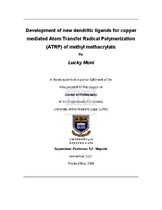| dc.contributor.advisor | Mapolie, S.F. | |
| dc.contributor.author | Moni, Lucky | |
| dc.contributor.other | | |
| dc.contributor.other | Faculty of Science | |
| dc.date.accessioned | 2014-02-10T13:22:08Z | |
| dc.date.available | 2010/01/05 03:52 | |
| dc.date.available | 2010/01/05 | |
| dc.date.available | 2014-02-10T13:22:08Z | |
| dc.date.issued | 2007 | |
| dc.identifier.uri | http://hdl.handle.net/11394/2837 | |
| dc.description | Philosophiae Doctor - PhD | |
| dc.description.abstract | A variety of nitrogen based dendritic ligands have been synthesized and used in copper mediated Atom Transfer Radical Polymerization (ATRP) of MMA. These ligands were derived from the commercially available Generation 1 polypropyleneimine dendrimer DAB-(NH2)4. The first set of ligands was synthesized by reacting DAB-(NH2)4 with aromatic aldehydes such as 2-pyridinecarboxyaldhyde and 4-t-butyl benzaldehyde to form imine functionalized dendrimers. Analogous secondary amine functionalized dendrimers were also synthesized by reducing the abovementioned imine functionalized dendrimers using sodium borohydride. The ligands produced were characterized by 13C / 1H NMR, and infra-red spectroscopy as well as elemental analysis to confirm its structure. The ligands were then used in copper mediated ATRP of MMA. The resulting polymer solutions were analyzed by Gas Chromatography (GC) to monitor the monomer conversion while the isolated
polymers were analyzed by gel permeation chromatography (GPC) for molecular weight determination. Results showed that the primary and secondary amine and imine dendritic ligands were not efficient in promoting ATRP reactions. This
led to the modification of DAB-(NH2)4 using methyl methacrylate to replace the peripheral amino groups of the DAB-(NH2)4 with tertiary amine groups. A second generation tertiary amine dendrimer was also synthesized in a similar fashion. The ligands obtained were then characterized using 13C and 1H NMR spectroscopy. The tertiary amine dendrimers were used in copper mediated ATRP of MMA. The polymerization medium was analyzed over time using GC to
monitor monomer conversion while GPC was used for molecular weight determination of the resulting polymers. The results obtained using the methyl methacrylate modified ligands indicated that in the case of MMA polymerization,
these ligands essentially conformed to the requirements of a good ATRP system. However in the preliminary studies, when employed in copper mediated ATRP of styrene, these ligands did not perform well. Further investigation is needed to
improve the performance of these ligands in styrene polymerization under ATRP conditions. | |
| dc.language.iso | en | |
| dc.publisher | University of the Western Cape | |
| dc.subject | Polymerization | |
| dc.subject | Atom transfer radical polymerization | |
| dc.title | Development of new dendritic ligands for copper mediated Atom Transfer Radical Polymerization (ATRP) of methyl methacrylate | |
| dc.type | Thesis | |
| dc.rights.holder | University of the Western Cape | |
| dc.description.country | South Africa | |

